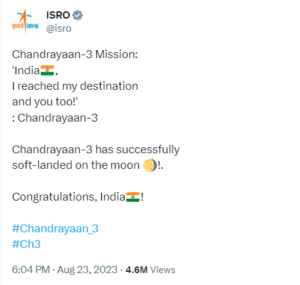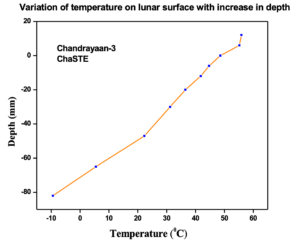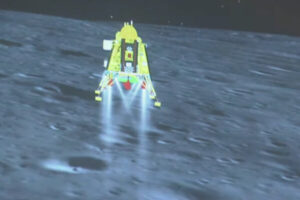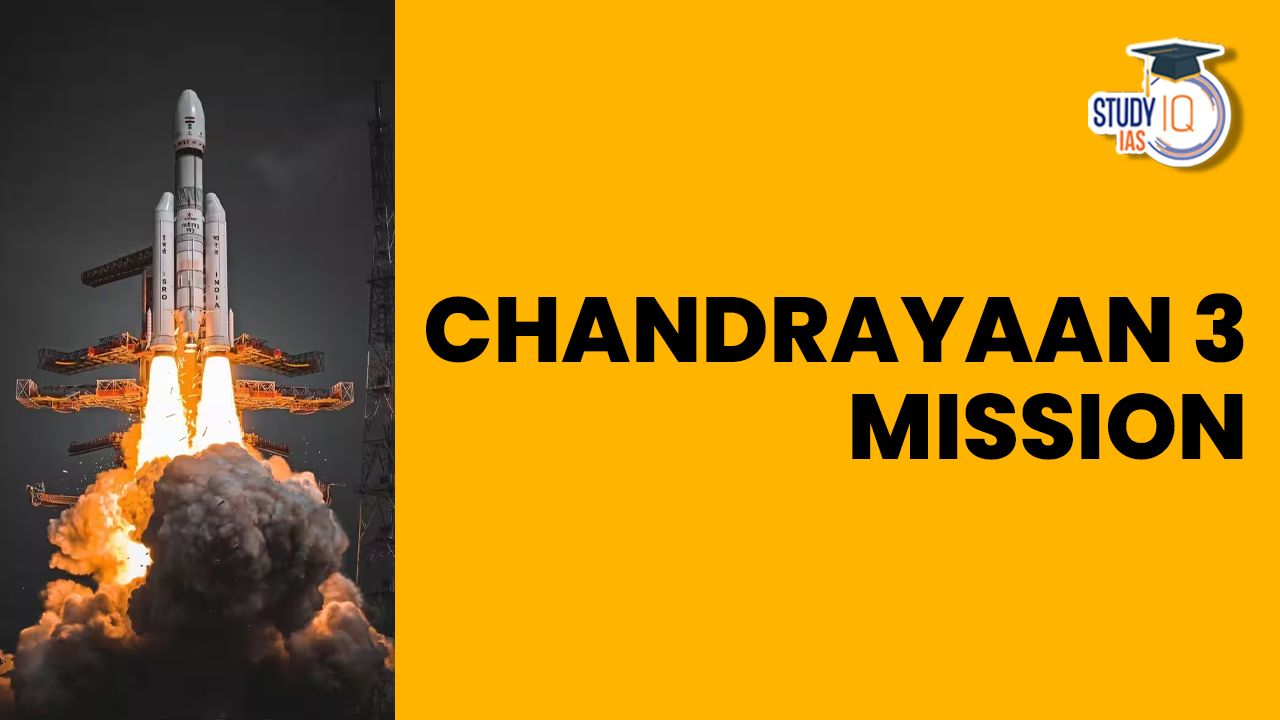Table of Contents
Context: A new study based on data collected by the Chandrayaan-3 mission has suggested that water ice could be present at more locations beneath the Moon’s surface at the poles than previously thought.
Key Findings from Chandrayaan 3 Mission Data
In-Situ Temperature Measurements by ChaSTE
- The ChaSTE (Chandra’s Surface Thermophysical Experiment) probe onboard the Vikram lander measured temperature at different depths (up to 10 cm) beneath the lunar surface.
- The lander touched down at 69° South latitude, near the Moon’s south pole at Shiv Shakti Point on August 23, 2023.
Key Temperature Observations
- The peak surface temperature at the landing site (Sun-facing slope, 6° angle) was 82°C during the day and dropped to -170°C at night.
- Just one meter away, on a flat surface, temperatures were significantly lower, peaking at 60°C.
- This difference suggests that even slight variations in slope impact surface temperatures, which in turn affect where ice can form and remain stable.
| Importance of Water Ice on the Moon |
|
How Slopes Affect Ice Formation
- Researchers developed a temperature model to understand how the angle of a slope influences surface temperature.
- Findings from the Model:
- Slopes facing the Sun → Absorb more heat, making them less likely to contain ice.
- Slopes facing away from the Sun (toward the lunar poles) → Remain cooler, allowing ice to accumulate closer to the surface.
- A slope with an angle greater than 14° could maintain temperatures low enough for ice to remain stable.
- Comparison with NASA’s Artemis Mission:
- The temperature conditions found in this study match the landing sites proposed for NASA’s Artemis program, which aims to explore the Moon’s south pole.
- This suggests that ice may be accessible in more locations than previously thought, making future lunar exploration easier and more resource-efficient.
| Why Liquid Water Cannot Exist on the Moon |
|
Chandrayaan 3 Landing Date and Time
Chandrayaan-3 completed all three phases successfully and completed the successful landing on the surface of the moon. Chandrayaan-3’s Vikram lander softly landed on the Moon around 6:04 pm on August 23, 2023. India created history by becoming the first nation to land the Indian Space Research Organisation’s Chandrayaan 3 spacecraft on the Moon’s south pole.
Historic Moment for India: Chandrayaan 3 successfully touched lunar soil which consists of an indigenous propulsion module, a lander module, and a rover module with the objective of developing and demonstrating new technologies required for interplanetary missions.

The 23rd of August is a historic day for India, as it marks the accomplishment of its lunar mission Chandrayaan3. On 26 August 2023, PM Modi announced it as ‘National Space Day‘, so that the story of India’s scientists’ success behind this mission reaches every future generation. From now onwards, every year, 23rd August will be celebrated as National Space Day.
About Chandrayaan 3
The first observations from the ChaSTE payload onboard Vikram Lander. ChaSTE (Chandra’s Surface Thermophysical Experiment) measures the temperature profile of the lunar topsoil around the pole, to understand the thermal behaviour of the moon’s surface.
It has a temperature probe equipped with a controlled penetration mechanism capable of reaching a depth of 10 cm beneath the surface. The probe is fitted with 10 individual temperature sensors. The presented graph illustrates the temperature variations of the lunar surface/near-surface at various depths, as recorded during the probe’s penetration. This is the first such profile for the lunar south pole. Detailed observations are underway.

Chandrayaan 3 Landing on Moon’s South Pole
Chandrayaan-3 Moon landing Date and Time Live Updates: After a 40-day journey starting from the Sathish Dhawan Space Center in Sriharikota, the Indian Space Research Organisation’s (ISRO) Chandrayaan-3 mission has landed successfully. The Vikram lander softly landed on the Moon’s South Pole, landing at 6.04 PM IST on August 23.
 India is the fourth country in the world to achieve this feat with a successful soft landing. ISRO believes this achievement will spark interest and curiosity in the youth about space exploration.
India is the fourth country in the world to achieve this feat with a successful soft landing. ISRO believes this achievement will spark interest and curiosity in the youth about space exploration.
Recently on 20th August 2023, a dismal conclusion to the mission was revealed by Roscosmos on Sunday afternoon Luna-25 Mission had crashed-landed on the Moon’s surface. Luna 25, also designated the Luna-Glob-Lander, was a Russian lunar lander mission that launched on 10 August 2023. This mission failed due to the crash on the moon’s surface.
Chandrayaan-3 Mission: Lander and Rover
Pragyaan Rover of Chandrayaan 3 Mission
The 26kg rover called Pragyaan (the Sanskrit word for wisdom) was carried to the Moon in the Vikram lander’s belly. It will now roam around the rocks and craters, gathering crucial data and images to be sent back to Earth for analysis.
Pragyaan is carrying two scientific instruments that will try to find out what minerals are present on the lunar surface and study the chemical composition of the soil.
Pragyaan will communicate only with the lander which will send the information to the orbiter from Chandrayaan-2 – which is still circling the Moon – to pass it on to the Earth for analysis. According to ISRO, the rover will move at a speed of 1cm per second – with each step it will also leave on the Moon’s surface the imprint of Isro’s logo and emblem embossed on its six wheels.
Vikram Lander of Chandrayaan 3 Mission
India has created history as it became the first country to land on the South Pole of the lunar surface. PM Modi congratulated Indians and space scientists for the achievement.
The real test of the mission began at the last leg of the landing. Prior to 20 minutes before landing, ISRO initiated Automatic Landing Sequence (ALS). It enabled Vikram LM to take charge and use its onboard computers and logic to identify a favourable spot and make a soft landing on the lunar surface.
Experts say that the final 15 to 20 minutes were highly crucial for the success of the mission when Chandrayaan-3’s Vikram lander descended down to its soft landing. Indians throughout the country and across the world prayed for Chandrayaan-3’s Successful Landing today.
Chandrayaan-3 entered the lunar orbit smoothly, precisely reaching the targeted orbital parameters of 164 by 18074 km. At the Perilune, a deft manoeuvre was carried out under the direction of the Mission Operations Complex (MOX) at ISTRAC, Bengaluru. Orbit reduction, a crucial stage in the mission strategy, is the next item on the schedule. This event is scheduled to occur on August 6, 2023, at about 23:00 Indian Standard Time (IST).

Pictures were reportedly taken by Chandrayaan-3 on August 5 during Lunar Orbit Insertion (LOI).
Chandrayaan-3 Landing Live Video
Here you can check the live streaming of Chandrayaan-3 spacecraft.
Chandrayaan 3 Mission Complete Details
India’s Chandrayaan-3 mission, carrying the hopes of an entire nation, has launched from Sriharikota in Andhra Pradesh in a magnificent demonstration of ambition and tenacity. If the mission is successful, India will join the United States, China, and Russia as the fourth nation to successfully conduct a controlled landing on the moon.
The powerful Mark 3 heavy-lift launch vehicle, commonly known as the Bahubali rocket, is holding the lunar lander, Vikram, in place. The spaceship will travel from Earth to the moon in about a month, with the projected landing day being August 23. Vikram will function on the lunar surface for one lunar day, which is equal to 14 days on Earth.
India’s third moon mission, Chandrayaan-3, is a continuation of Chandrayaan-2, which was launched in July 2019 and has as its goal to place a rover on the lunar South Pole. The Satish Dhawan Space Centre in Sriharikota has launched the mission on July 14, 2023, using a Launch Vehicle Mark 3 (LVM3). Due to the COVID-19 pandemic’s delay in its production, India is ready to launch Chandrayaan 3 in 2022.
Chandrayaan 3 Mission Background
The third lunar exploration mission, as planned by the Indian Space Research Organisation (ISRO), will use the Chandrayaan 3 spacecraft. This spacecraft was designed by ISRO to showcase India’s expertise in soft landings on stellar bodies. Only a rover and lander will be present, and it will only connect with the Earth through an orbiter from Chandrayaan 2.
This expansive purpose includes integration, cognition, and several permutations. In addition, the spacecraft still needs to undergo a number of other thorough tests.
The orbiter, rover, and lander were all included in the design of the Chandrayaan 2 spacecraft by ISRO. This spacecraft was launched using the GSLV-Mk 3, one of the most powerful geosynchronous launchers.
The rover Pragyaan’s attempt to travel on the Moon was hampered by the lander Vikram’s failure to make a smooth landing. In order to demonstrate India’s landing skills needed for the Lunar Polar Exploration Mission, another mission was attempted as a result. In 2024, this Moon South Pole mission will be carried out in cooperation with Japan. India will contribute a lander, and Japan will contribute a rover and rocket.
Lander payloads: Langmuir Probe (LP) to calculate the plasma density and its changes; Chandra’s Surface Thermophysical Experiment (ChaSTE) to measure thermal conductivity and temperature; Instrument for Lunar Seismic Activity (ILSA) to measure seismicity around the landing site. For lunar laser ranging research, a NASA passive Laser Retroreflector Array is available.
Rover payloads: Alpha Particle X-ray Spectrometer (APXS) and Laser Induced Breakdown Spectroscope (LIBS) for deriving the elemental composition in the vicinity of the landing site.
Chandra Surface Thermophysical Experiment (ChaSTE): While the Instrument for Lunar Seismic Activity (ILSA) measures the seismicity at the landing site, it will measure thermal conductivity and temperature.
With a rover and lander, the Chandrayaan 3 mission launched into space. No orbiter like Chandrayaan 2 was present. In particular, regions of the Moon’s surface that haven’t seen sunlight in a few billion years are being examined by India. Scientists and astronomers believe that these darker regions of the lunar surface may contain ice and rich mineral deposits.
Additionally, this exploration will not only focus on the surface but also attempt to investigate the exosphere and subsurface. An orbiter from Chandrayaan 2 will be used by the rover of this spacecraft to connect with Earth. At a distance of 100 km from the lunar orbit, it will take photographs to examine the surface.
Features of Chandrayaan 3 Moon Mission
A rover and lander were aboard Chandrayaan 3 as it launched into space. There won’t be any orbiters like Chandrayaan 2 in it. India wants to look at the Moon’s surface, particularly in regions that haven’t seen sunlight in a few billion years. These darker regions of the lunar surface may contain ice and rich mineral deposits, according to scientists and astronomers. Additionally, this exploration will try to examine the exosphere and subsurface as well as the surface.
This spacecraft’s rover will interact with Earth through an orbiter salvaged from Chandrayaan 2. At a distance of 100 km from the lunar orbit, it will take pictures of the surface in order to analyze it.
Reason to Target Moon’s South Pole for Chandrayaan 3 Mission
Chandrayaan 3 will primarily target the Moon’s southern pole because it has more shadowed space than the northern pole. These regions of the lunar surface may have a constant supply of water, according to scientists. Additionally, the craters found at the southern pole are of great interest to scientists. They think the cryptic fossil records of the early planetary system may be present in these cold traps.
Chandrayaan-3 Budget
With a ₹615 million budget, India’s Chandrayaan-3 project seeks to deploy a rover and place a lander on the moon’s surface. It will research the moon’s characteristics, seismicity, plasma environment, and composition after launching on 14th of July.
Chandrayaan-3 and Chandrayaan-2
The names Vikram and Pragyan will be carried over to the Chandrayaan-3 mission, according to ISRO Chairman. This choice honours the 2019 Chandrayaan-2 lunar mission and highlights India’s dedication to its space exploration tradition. There are some other differences between Chandrayaan-3 and Chandrayaan-2 given below:
Simplified Payload
Chandrayaan-3 will just have a lander and a rover, as opposed to Chandrayaan-2, which also has an orbiter, the Pragyan rover, and the Vikram lander. During the mission, the orbiter that was launched with Chandrayaan-2 will be used for communication and terrain mapping needs. Chandrayaan-3’s propulsion module will house a single instrument called ‘Spectro-polarimetry of habitable planet Earth’ (SHAPE), as opposed to Chandrayaan-2’s orbiter, which carries nine in-situ instruments.
Enhanced Lander Capabilities
‘Lander danger identification & avoidance cameras’ are a feature of Chandrayaan-3 that let mission control, the orbiter, and the lander communicate when the lander is descending to the lunar surface. Compared to its predecessor’s single camera, Chandrayaan-3 will have two of these cameras.
Chandrayaan 3 Mission: Overcoming Past Challenges
When a failed attempt at a soft landing resulted in the loss of the lander-rover combo and the payloads, the Chandrayaan-2 programme suffered setbacks. Unfazed by the failure of the first mission, ISRO revealed its intentions for Chandrayaan-3, which aims for a successful lunar landing.


 Genetically Modified Crops in India, Reg...
Genetically Modified Crops in India, Reg...
 What are Polycyclic Aromatic Hydrocarbon...
What are Polycyclic Aromatic Hydrocarbon...
 MALE Class Drones: Capabilities, Payload...
MALE Class Drones: Capabilities, Payload...





















